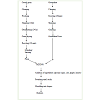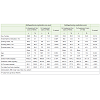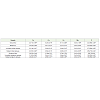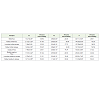Research Article
Effects of Malting and Roasting of Millet and Sorghum on Protein Digestibility, Mineral Availability, Soluble Sugar Composition and Consumer Acceptability of Dakuwa
I Nkama1,3*, DI Gbenyi3 and BR Hamaker2
1Department of Food Science & Technology, University of Nigeria, Nsukka, Enugu State, Nigeria
2Department of Food Science, Purdue University, West Lafayette, IN 47907-1160
3Department of Food Science and Technology, University of Maiduguri, P. M. B 1069, Maiduguri, Borno State
Corresponding author: I Nkama, Department of Food Science & Technology, University of Nigeria, Nsukka, Enugu State,Nigeria, Tel No. +234-803-428-1885; E-mail: ironkamas@yahoo.com
Citation: Nkama I, Gbenyi DI, Hamaker BR. Effects of Malting and Roasting of Millet and Sorghum on Protein Digestibility, Mineral Availability, SolubleSugar Composition and Consumer Acceptability of Dakuwa. Indian J Nutri. 2015;2(1): 113.
Copyright © 2015 Nkama I, et al. This is an open access article distributed under the Creative Commons Attribution License, which permits unrestricted use, distribution, and reproduction in any medium, provided the original work is properly cited.
Indian Journal of Nutrition | ISSN: 2395-2326 | Volume: 2, Issue: 2
Submission: 21/09/2015; Accepted: 13/10/2015; Published: 19/10/2015
Abstract
The effects of germination and roasting of pearl millet and sorghum on the hydrochloric acid extractability of minerals, in vitro protein digestibility andacceptability of “dakuwa” (a cereal - groundnut based snack food) was investigated. Results show that there was a significant increase (p < 0.01) in theextractability of calcium, phosphorous and iron from malted millet and sorghum dakuwa. Germination of pearl millet and sorghum increased calcium extractabilityof dakuwa samples from 31.51 to 63.45 %, while iron and phosphorus extractabilities increased from 15.48 to 43.20 % and 39.02 to 62.23 % respectively. Theapparent protein digestibility of the dakuwa samples produced from malted millet and sorghum grains was significantly (p < 0.01) higher than that from theun-germinated grains. The germination of sorghum and millet prior to dakuwa production also significantly (p < 0.01) increased the soluble sugars contents(maltose, sucrose, glucose and fructose) of the final products. Sensory evaluation of the dakuwa samples revealed that malted and un-malted samples wereall acceptable to consumers, although sorghum based dakuwa was rated slightly higher than the millet based ones. No sample was rated as poor.
Keywords: Sorghum; Millet; Malting; Roasting; Protein digestibility; Mineral availability
Introduction
Pearl millet and sorghum are used in a wide variety of snackfoods made in every conceivable manner. In India and some WestAfrican countries pearl millet and sorghum are popped or patched,malted, eaten directly or used to produce various snacks, beveragesand pregelatinized weaning foods [1-4].
“Dakuwa” is one such snack food product produced fromsorghum, pearl millet, maize, tiger nuts and groundnut. It is a commonfood to the people living in Northern part of Nigeria especially theHausas. In the traditional method of its production, the grains are cleaned, roasted and ground together to form a cohesive mass withthe addition of sugar syrup, which is then moulded into small balls forsale [2] by children hawkers. Because it is a high protein energy food,dakuwa can serve as a good source of nutrient supplement to wartorn and famine ravaged areas for growing children, adults, lactatingwomen and the sick. Dakuwa is produced without consideration tothe presence of anti-nutritional factors such as phytates and tannins.
Several studies have shown that germination improves thenutritive value of the sprouts over the ungerminated seeds [5,6].Germination in addition to soaking and roasting has been found todecrease the levels of antinutrients present in the grain and maximize the levels of some utilizable nutrients [8-11]. Nkama & Gbenyi [10]investigated the effects of malting, and roasting on the residualphytate and tannin content of dakuwa. Phytate was reduced by 58% and 57% receptively in malted millet-groundnut, and maltedsorghum - groundnut dakuwa. Tannins were reduced by 91.4% and72.1% respectively in the same products. There are no reports on theeffects of malting and roasting on mineral availability, in vitro proteindigestibility, sugar composition and acceptability of dakuwa. Theobjective of this study was to provide this information.
Materials and Methods
Pearl millet (Peninsetum glaucum) variety Zango was obtainedfrom Lake Chad Research Institute, Maiduguri, Nigeria. Redsorghum (Sorghum bicolor), groundnut (Ex-Dakar), ginger (Zingiberofficinale), hot pepper (Capsicum annum) and salt were purchasedfrom Maiduguri, Monday market, Nigeria.
Sample preparation
All grains, except groundnut were cleaned using a laboratoryaspirator (Vegvari Ferenc Aspirator, type OB125, Hungary) toremove stalks, leaves and other foreign matter. They were thenseparately washed with clean tap water and sun dried. All grainsincluding groundnut were roasted to a light brown colour prior togrinding. The seed coat of the roasted groundnut was removed byfirst rubbing between the palms of the hand and then winnowing[2]. Defective groundnuts such as burnt and immature ones wereremoved by manual picking prior to grinding. The roasted grainswere separately ground using a laboratory attrition grinder (Amuda,India). Grinding was such that 92.6% of the flour passed through a400μm mesh sieve. Ginger, pepper were cleaned and dried in air oven(Chirana type HS 201A, Czechoslovakia) set at 100 °C for 2 hr beforegrinding and sieving to pass 400 μm mesh sieve.
Malt preparation
The millet and sorghum were steeped for 12 hr, germinated for 24hr and then oven dried at 50 °C. The roots and shoots were removedby hand rubbing [12].
Proximate analysis
Moisture, protein, fat, crude fiber and ash were determinedaccording to AOAC [13] methods. Carbohydrate was determined bydifference [14].
Preparation of dakuwa
The process reported by Nkama [2] was adopted with somemodifications (Figure 1). The cereal component was malted andhoney was also added. Millet and sorghum grains were malted asdescribed previously, and then roasted, ground before blending. Allingredients were mixed dry and pounded in a wooden mortar withpestle until very sticky. The honey was added as a binder to facilitatemounding of the dakuwa into the desired shapes.
Mineral analysis
Minerals comprising Ca, Cu, Fe, and Mn were determined by theAACC [15] procedure using Atomic Absorption spectrophotometer(model: Perkin -Elmer-2380). The hydrochloric acid (HCI) extractable mineral was determined by the method described by Khetarpaul &Chauhan [16]. 1 g of sample was extracted with 0.03 N HCl solutionfor 3 hr at 37 °C. The filtrate was dried and the residue reported asthe proportion of the total extractable mineral. Total phosphoruswas determined spectrophotometrically by method of Osborne andVoogt [17]. The HCl extractable phosphorus was determined by themethod reported by Khetarpaul & Chauhan [16].
Soluble protein and in vitro protein digestibility
Soluble protein was determined by dissolving 2 g of each samplein 20 ml distilled water at 38 °C and filtering. The filtrate was collected,dried in air oven at 100 °C for 4 hr and soluble protein contentdetermined by Kjeldahl method [18]. In vitro protein digestibilityof samples was determined by the procedure described by Oke andUmoh [19]. 1.0 g of defatted meal was suspended in 1.0 ml 0.01 NNH4Cl and shaken for 48 hr at 35 °C. After centrifugation, the residuewas re-suspended in 10 ml of distilled water and 10ml of 0.1 N sodiumsulphate buffer, pH 8.0 added and then treated with 5 mg of trypsin(Garrad Biological Centre). The mixture was incubated for 16 hr at35 °C and centrifuged at 1000 g. The residue was washed, dried in an air oven and analyzed for nitrogen [17]. Percent digestibility wascalculated as loss of original nitrogen in the sample after enzymaticdigestion.
Soluble sugars
2.5 g of each sample was extracted in 25 ml distilled water at 65 °C,cooled and filtered. The filtrate 2 ml was taken into 10 ml volumetricflask and made up to volume with distilled water. The absorbance wasread using a spectrophotometer (UNICAM UV2 QUARTZ system)at 280 nm for maltose and fructose, 376 nm for sucrose, and 390 nmfor glucose [17].
Sensory evaluation
The hedonic scale was used to assess the degree of acceptability ofthe modified dakuwa samples in relation to the traditional one using15 untrained panelists familiar with dakuwa seated in air conditionedindividual boots in the sensory evaluation laboratory of theDepartment of Food Science and Technology, Federal polytechnic,Mubi, Nigeria. Samples molded into cube forms were served in cleanplastic plates. The panelists were provided with clean portable waterfor oral rinsing between samples. They were asked to rate the colour,texture, taste, flavour and overall acceptability of samples. The bestsample was ranked 6.0 with descriptive term ‘excellent’ while theworst sample was ranked 1.0 with descriptive term ‘very poor’ [20].
Statistical analysis
The statistical analyses were carried out using the analysis ofvariance procedure of the Statistical Analysis System [21]. Meanswere separated using Duncan Multiple Range Test (DMRT) method[22].
Results and Discussion
Proximate composition
The proximate composition of dakuwa samples is given in Table 1. There were significant differences (p ≤ 0.05) in the proximatecomposition of samples with respect to protein, fat, fibre andcarbohydrates. Protein ranged from 15.01 to 16.42% and fat 19.87-24.96%. The traditional dakuwa had the highest amount of fatcompared to the other samples. The moisture content of samples waslow and ranged from 5.93 - 6.36%. Addition of groundnut improvedthe nutrient composition of the product. The protein content ofsamples was within the range recommended for high protein foodproducts.
Mineral composition and HCl extractable minerals
The mineral composition of millet flour, sorghum flour,groundnut and dakuwa from them is given in Table 2. There weresignificant differences (p ≤ 0.01) in the mineral composition ofsamples. Millet flour had more calcium and copper than sorghumand groundnut flour. Groundnut had more iron and manganese thanmillet and sorghum flour. The mineral composition of the dakuwasamples followed that of the raw materials used in their preparation.The iron and calcium content of millet, sorghum and groundnut aresimilar to reported values [23]. Generally mineral composition waslow. It is suggested that if dakuwa is to be produced commercially,mineral fortification would be required especially if it is to be used asa supplementary food for the vulnerable groups.
Table 3 shows the effect of germination on the hydrochloricacid (0.03N HCl) extractability of calcium, phosphorus and iron.There was a significant increase (p ≤ 0.01) in the extractability of both calcium and iron from the germinated millet and sorghumflours. Germination of pearl millet and sorghum increased calciumextractability from 38.59 to 61.99 % and 26.51 to 61.49 % respectively.Iron extractability increased from 22.03 to 36.56% for millet and 14.34to 24.63% for sorghum flours. Similarly, phosphorus extractabilityincreased from 28.51 to 43.0 5 % for millet and from 31.02 to 42.09%for sorghum.
These results are similar to values reported by Khetarpaul &Chauhan [16]. The HCl extractability of phosphorus, calcium andiron is indication of their bioavailability to humans [16]. The increasesin HCl extractability of calcium, phosphorus and iron may be dueto the breakdown of phytates and polyphenols in these cereals byenzymes during germination [8,10]. Nkama & Gbenyi [10] reportedphytate reduction of 58 % and 57% respectively for malted dakuwafrom sorghum and millet. Also tannin was reduced by 91.4% and 72.1% respectively in malted millet and sorghum dakuwa. The calcium,phosphorus and iron content of dakuwa samples from germinatedmillet and sorghum were also observed to double that of the dakuwafrom ungerminated ones.
Protein solubility and in vitro protein digestibility
Table 4 shows the results of protein solubility and in vitroprotein digestibility of raw grain samples, roasted flour and dakuwa Table 4 shows the results of protein solubility and in vitroprotein digestibility of raw grain samples, roasted flour and dakuwa
Table 4 also shows the apparent protein digestibility (in vitro)of samples. There were significant differences in apparent proteindigestibility (p ≤ 0.01). Raw sorghum grain flour had the lowestdigestibility (38.29%). Hamaker et al. [25] made similar observations.The reason for this low protein digestibility is not very clear. Itmay however be due to the presence of kiffirins, which are the lastproteins to be digested in sorghum flour [25,26] or probably due tothe presence of polyphenols, which bind proteins and make themunavailable for digestion [27]. Malted millet dakuwa had the highestapparent protein digestibility (71.47%), while unmalted sorghumdakuwa had the lowest apparent protein digestibility after 16 hrenzyme digestion. Generally, malted cereal based dakuwa sampleshad higher apparent digestibility values compared to dakuwa fromunmalted cereal dakuwa samples. This may be due to the hydrolysis ofthe anti-nutrients such as phytate and polyphenol during germination [25,27]. Nkama and Gbenyi (10) reported a significant degradationof phytates (57-58%) and polyphenol (72-91%) in dakuwa producedfrom malted millet and malted sorghum.
Soluble sugars
There was significant increase (p ≤ 0.01) in the concentrationof all sugars in the germinated sorghum and millet and the dakuwaproduced from them (Table 5). These increases may be due to diastaticactivity caused by germination of the grains. Subramanian et al. [28]and Khetarpaul and Chauhan [25] also reported significant increasesin diastatic activity and in vitro starch digestibility when sorghum andmillet grains were respectively germinated. Maltose increased by 71%in malted millet based dakuwa and 64 % in the malted sorghum basedone. Also fructose increased by 52% in malted millet based dakuwaand 68% in malted sorghum based dakuwa [28,29].
Sensory properties
The results of the sensory properties of the malted and traditionaldakuwa samples are given in Table 6. There were no significantdifferences among samples in terms of texture and flavor. There werehowever significantly differences (p ≤ 0.01) in overall acceptability andcolour. Unmalted sorghum dakuwa had the highest rating, followedby the traditional dakuwa, and then malted sorghum dakuwa. Themalted millet dakuwa was rated lowest in overall acceptability. Nosample was rated as ‘poor’ or “very poor”. The reason for the lowoverall acceptability of millet based dakuwa may be due to the factthat the sensory evaluation was conducted in a location (AdamawaState) in Nigeria where sorghum is the most popular cereal and thered sorghum is the most preferred for the production of dakuwa.
Conclusion
The study has revealed that an acceptable dakuwa with increasedprotein digestibility, soluble sugars and mineral availability can beproduced from malted pearl millet and sorghum. Efforts should bedirected along this line in attempt to commercialize the product. Thestorage and packaging studies of dakuwa should be investigated aseffort is geared to popularize it in the country. Since one of the majoringredients groundnut is associated with mycotoxins effort should bemade to screen groundnuts used for dakuwa production.
Acknowledgement
This study was supported in part by grants from the SWISSCorporation to West and Central African Millet Research Network(ROCAFREMI-WCAMRN) through Lake Chad Research Instituteand from INTSORMIL Management Entity, University of Nebraskato University of Maiduguri.
References
- Nkama I, Malleshi NG (1998) Production and nutritional quality of traditional Nigerian masa from mixtures of rice, pearl millet, cowpea and groundnut. Food and Nutrition Bulletin 19: 336-373.
- Nkama I (1993) Traditional Methods of production of high protein energy foods from grain legumes in the North-Eastern States of Nigeria. Annals of Borno 10: 138-148.
- Gaffa T, Jideani, IA, Nkama I (2000) Traditional production, consumption and storage of kunu - a non alcoholic cereal beverage. Plant Foods Hum Nutr 57: 73-81.
- Rooney LW and Waniska RD (2000) Sorghum food and industrial utilization in Smith CW and Frederiksen RA (Eds), Sorghum: Origin, History, Technology, and Production, John Wiley and Sons, Inc., N. Y., pp 689-729.
- Correia I, Nunes A, Barros AS, Delgadillo I (2008) Protein profile and malt activities during germination. J Sci Food Agric 88: 2598-2605.
- Fordham RR, Wells CE, Chen LH (1975) Sprouting of seeds and Nutrient composition of seed and sprouts J Food Sci 40: 552-556.
- Elkalifa AO, Bemharddt R (2010) Influence of grain germination on functional properties of sorghum flour. Food Chemistry 121: 387-392.
- Badau MH Nkama I and Jideani IA (2005) Phytic acid content and hydrochloric acid extractability of minerals in pearl millet as affected by germination time and cultivar. Food Chemistry 92: 425-435.
- Correia I, Nunes A, Barros AS, Delgadillo I (2010) Comparison of effects induced by different processing methods on sorghum protein. J Cereal Sci 61: 146-151.
- Nkama I and Gbenyi DI (2002) The effect of malting of millet and sorghum on the residual phytates and polyhpenols in dakuwa - a Nigerian cereal - legume snack food. Nigerian Journal of Tropical Agriculture 3: 76- 85.
- Agte VV, Joshi SR (1997) Effects of traditional food processing on phytate degradation in wheat and millets. Journal of Agriculture and Food Chemistry 45: 1659-1961.
- Nkama I Tegomoh, MT and Addy EO (2000) Studies on the malting characteristics of some local cereals. Journal of Arid Agriculture 10: 139-143.
- Association of Official Analytical Chemists (AOAC) (1984) Official Methods of Analysis, 14th edn., Washington, D.C.
- Egan H Kirk RS and Sawyer R (1981) Pearson’s Chemical Analysis of Foods, 8th edn., Churchill Livingstone Press, Edinburgh, London and New York, NY, pp.313-318.
- AACC (1986) Approved Methods of the Association of Cereal Chemists. St Paul, Minn, USA: American Association of Cereal Chemists.
- Khetarpaul N, Chauhan BM (1989) Effect of germination and pure culture fermentation on the HCl-extractability of minerals of pearl millet (Penninsetum typhoideum). Food Sci Technol Int 24: 327-331.
- Osborne DR and Voogt P (1978) The Analysis of Nutrients in Foods Academic Press London New York San Francisco.
- Gomez MI, Obilana AB, Martin DF, Madzvamuse M, Monyo ES (1997) Manual of laboratory procedures for quality evaluation of sorghum and pearl millet, Technical Manual No.2 (in En. Abstracts in Fr.) International Crops Research Institute for the Semi-arid Tropics (ICRISAT), Patancheru 502 324, Andra Pradesh, India.
- Oke OL, Umoh IB (1974) Nutritive value of leaf protein, a note on the comparison of in vitro and in vivo methods. Nutrition Report International 10: 397-403.
- Larmond E (1976) Laboratory Methods for Sensory Evaluation of Food, Canadian Government Publishing Centre, Ottawa, Canada KIA 059.
- Statistical Analytical System (SAS) (1996) SAS/STAT User’s Guide Version 6.12. 4 edn. Vo1 2. SAS Institute Inc. Cary, NC, USA, pp. 1675.
- Gomez KA, Gomez AA (1983) Statistical Procedure for Agricultural Research 2nd edn. John Wiley and Sons, New York, NY.
- Platt BS (1962) Tables of Representative Values of Foods Commonly Used in Tropical Countries. Publication of Medical Research Council. Special Report Series No. 302.
- Khetarpaul N, Chauhan BM (1990) Effect of germination and fermentation on in vitro starch and protein digestibility of pearl millet. J Food Sci 55: 883-884.
- Hamaker BR, Kirleis AW, Butler LG, Axtell JD, Mert ET (1992) Improving the in vitro protein digestibility of sorghum with reducing agents in Gomez, MI House, LR Rooney, LW and Dendy, DAV (Eds), Utilization of Sorghum and Millet., International Crops Research Institute for the Semi-arid Tropics, Patancheru, India, pp. 61-62. `
- Hofsten BV (1979) Legume sprouts as a source of protein and other nutrients. Journal of American Oil Chemists’ Society 56: 382.
- Subramanian V, Murty DS, Rao NS, Janbunathan R (1992) Chemical Changes and diastatic activity in grains of sorghum (Sorghum bicolor) cultivars during germination. J Sci Food Agric 58: 35-40.
- Oria MP, Hamaker BR, Shull JM (1995) Resistance of sorghum α-, a-, M.P. Journal Agriculture and Food Chemistry 43: 2148-2153.
- Badau MH, Nkama I, Jideani JA (2005) Sugar content of pearl millet as diversed among cultivars and affected by germination. Journal of Applied Glycosccience 52: 331-335.







